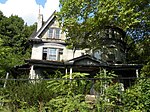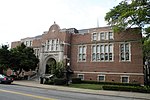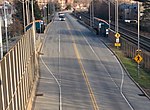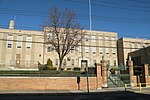Lemington Elementary School
Allegheny County, Pennsylvania Registered Historic Place stubsArt Deco architecture in PennsylvaniaCity of Pittsburgh historic designationsNational Register of Historic Places in PittsburghPittsburgh History & Landmarks Foundation Historic Landmarks ... and 4 more
Pittsburgh building and structure stubsSchool buildings completed in 1937School buildings on the National Register of Historic Places in PennsylvaniaSchools in Pittsburgh

The Lemington Elementary School in the Lincoln-Lemington-Belmar neighborhood of Pittsburgh, Pennsylvania is a building from 1937. Portions of the exterior are ornamented with terracotta, and feature Mayan-inspired motifs such as an amber sunburst frieze and stylized human faces. It was listed on the National Register of Historic Places in 1986.
Excerpt from the Wikipedia article Lemington Elementary School (License: CC BY-SA 3.0, Authors, Images).Lemington Elementary School
Lemington Avenue, Pittsburgh
Geographical coordinates (GPS) Address Nearby Places Show on map
Geographical coordinates (GPS)
| Latitude | Longitude |
|---|---|
| N 40.4701 ° | E -79.8965 ° |
Address
Lemington Elementary School
Lemington Avenue
15206 Pittsburgh
Pennsylvania, United States
Open on Google Maps










